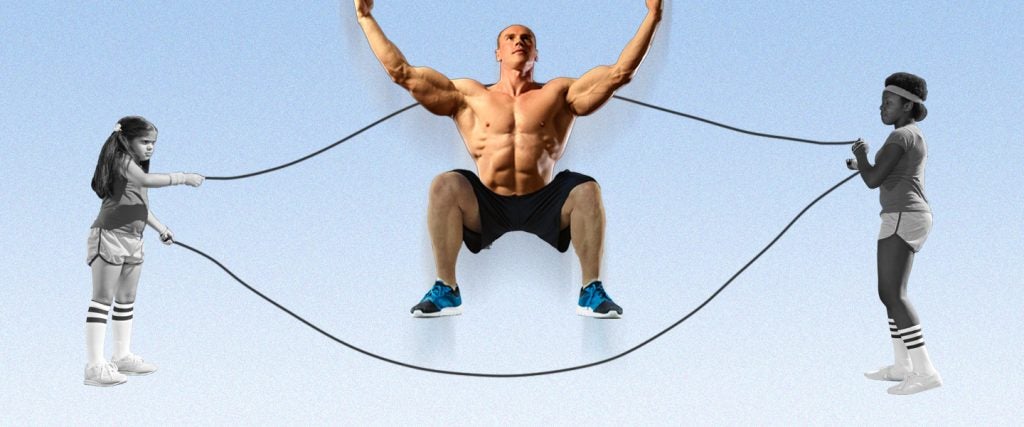If your progression in understanding and appreciating jump ropes is anything like mine, it’s going to begin with a feeling of total revulsion. More than likely, that disgust will be borne out of a belief that any form of rope jumping needs to be accompanied by a chorus about Cinderella being “dressed in yella.” Whether or not you ultimately want to go upstairs to kiss a fella is entirely up to you, but it usually takes young men reaching their teenage years — or viewing their first Rocky film — before they realize just how excruciating of an exercise rope jumping can be, or that being able to execute double-under crossovers is a telltale sign of badassery.
Once you develop enough of a skipping rhythm to be able to string together 30-second rounds of jumping, your sweaty brow, pounding chest and aching calves will rapidly convey the message that jumping rope is a brutal business, and one that requires a lot of energy. If you can sustain a rope-jumping groove and overcome the pounding of your feet against the pavement, that schoolyard activity that you once thought would undoubtedly leave you with a pestilential case of the cooties will transform into one of the most reliable calorie incinerators in your training arsenal.
That’s exciting! So how many calories can I burn jumping rope?
Quite frankly, you can burn all of them if you put enough time and effort into it. Jumping rope at a respectable pace — which requires you to hop around at a cadence much too fast for you to bound around to the lyrics of Mary Mack — means that you’re going to be skipping around at about two jumps per second. At that rate, if you weigh 150 pounds or more, you should burn between 13 and 18 calories per minute. Those are some serious calorie-burning, cardiovascular benefits within your reach if you manage to extend your rope-jumping session for even 20 minutes. However, chances are you won’t be able to burn that many calories when you jump rope.
Why wouldn’t I be able to burn that many calories jumping rope?
I’m not questioning your ability; it’s just not that easy to jump rope, period. It’s nice to get a rhythm going, and to string together a series of jumps that can last a few minutes at a time, but having the cardiovascular endurance and the calf-muscle stamina to string together five solid minutes of jumping is relatively rare. Equally as rare is the coordination required to prevent the rope from getting caught in your feet more than once every 30 jumps or so.
Then there’s the matter of momentum. In the same fashion that it’s mentally defeating to be forced to stop running at a red light, it’s equally discouraging to get yourself tripped up by the rope every single minute, or even once every three to four minutes. The smart money says that you’re going to get tangled in the rope one too many times, curse loudly, throw the rope against the wall and depart in search of a treadmill to jog upon.
My challenge to you would be to set aside at least 20 minutes to jump rope, and then decide well in advance that you’re going to fill those 20 minutes with as many rope-skipping repetitions as you possibly can. It may test the limits of your mental fortitude to be forced to endure so many failures, but you can’t allow yourself to feel defeated. Rope jumping is one of the rare cardiovascular training methods where there’s an implement involved that can literally trip you up. No matter how desirous you are of continuing your session, one errant hop can bring your skipping groove to an abrupt end. This can be incredibly frustrating when both the spirit and body are willing, but the concentration is weak.
Another source of rope-jumping frustration stems from the inability to find a sufficient space to jump in. Realistically speaking, if you’re jumping rope, you require sufficient rope length for the strand to comfortably clear several inches over your head without also becoming unwieldy and disrupting your timing. If you’re anywhere near 6-feet tall, you likely require at least 78 inches of clearance in all directions to ensure that the rope won’t manage to get inadvertently snagged on something — or someone.
This sounds like a lot to think about.
It really isn’t.
Adopt a similar attitude toward jumping rope that you do toward lifting weights: The majority of new muscular strength is acquired at the point of failure, so failure is the goal. No, failure isn’t technically the goal of jumping rope, but if you adopt the disposition that failing is an imminent step toward success in rope jumping, in a similar sense to how it’s an unavoidable step in the progress toward the acquisition of stronger muscles, then you’ll be able to shake it off, and keep hopping. Whether the song in your head is “Teddy Bear Turn Around” or “Going the Distance” is irrelevant, as long as you complete your appointed training and actually go the distance.

